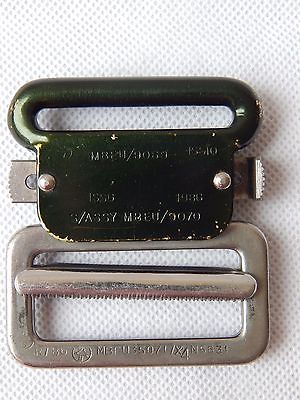
How Ejection Seats influenced Cobra® buckles
The need for an extremely secure yet lightening fast quick release has been in demand for military applications for thousands of years. In 500 BC Roman soldiers first used the cage and prong design (still used on millions of traditional belts) to quickly fasten their helmets.
In 1942 with the dawn of the jet age, the need to allow pilots to quickly eject from a plane was critical. Enter James Martin founder of the Martin Baker Aircraft Systems who is the inventor of the first ejection seat and accompanying quick release buckle (see photo below).



The Cobra® buckle is a descendant from the early days of ejection seats and quick release buckles. The technology and machining methods have greatly improved making the latest Cobra® buckles lightweight, secure and extremely reliable. That's why Klik Belts only uses Cobra buckles in all belts and nothing else. Cheap imitations have flooded the market from Asia but as soon as you hear the sound of the click on a Cobra® you know it's absolutely secure. Take a sneak peak inside the Austrian Factory where Cobra® are crafted.
For more background on the Martin Baker company please see the excerpt below from Wikipedia.
The death of Valentine Baker in an aircraft accident in 1942 prompted James Martin to investigate new methods for aircrew escape and survival. Martin had previous experience of aircraft survival systems and had designed a quick-release canopy system during the Battle of Britain, a very successful device that was later fitted as standard to all Spitfires during manufacture.[1]
In 1944 Martin was approached by the Air Staff after a fatal accident with the jet-powered Gloster F.9/40 (Gloster Meteor prototype).[2]They asked for an escape system that forcibly ejected the pilot from an aircraft and was powerful enough to clear the tail surfaces at high airspeeds. German and Swedish engineers were investigating the same problem, but Martin was unaware of this.[3]
Martin initially investigated systems that could be retro-fitted to existing fighter aircraft types that were in service at the time. His first design, a spring-powered swinging arm, hinged near the base of the fin, was not pursued although a Boulton Paul Defiant aircraft had been loaned to the Martin-Baker company for modification and testing.[3]
A method using explosive charges to clear the seat from an aircraft was investigated next, as no information was available on what effect the g-forces might have on the human body a 16 feet (4.9 m) test rig was constructed at Denham for readings to be taken. On 20 January 1945 a 200 pounds (91 kg) dummy was test fired on the rig, four days later a company fitter, Bernard Lynch volunteered to test the system and was fired to a height of just under 5 feet (1.5 m) with no ill effects felt. The size of the explosive charge was progressively increased until Lynch reached a height of 10 ft and declared that he was experiencing pain. News of the test quickly reached the aviation press, a journalist from The Aeroplane was hospitalised with crushed vertebrae after trying out the rig for himself.[4]
James Martin was very concerned by this development and worked hard to reduce the peak acceleration loads felt by the occupant, the solution was to use a second charge firing in sequence and alterations to the seat to provide a posture that would protect the spine. Foot rests and a face blind firing handle were added.[5]
Almost 200 tests were completed on the 16 ft rig when testing transferred to a new 65 feet (20 m) rig, Bernard Lynch again being the first to use it on 17 August 1945, reaching a height of just over 26 feet (7.9 m). The need for airborne testing was apparent, the Defiant loaned for testing had its rear turret removed and a loaded seat had been fired from it whilst stationary on the ground on 10 May 1945. The next day the test was repeated in the air, a further five tests up to indicated airspeeds of 300 miles per hour (480 km/h) were successful.[6]
On 12 September 1945 the Martin-Baker company was awarded a contract to design and produce two seats for high-speed testing, a Gloster Meteor aircraft was modified for testing. The first airborne test with this aircraft took place over Chalgrove airfield in June 1946. Using a dummy the parachute failed when it opened prematurely at a speed of 415 miles per hour (668 km/h). A time-delay release mechanism was developed and initially suffered from problems. After many more tests it was felt that the system was safe enough for a manned live test. The volunteer was again Bernard Lynch, firing himself from the rear cockpit of the Meteor at 8,000 feet (2,400 m) over Chalgrove on 24 July 1946, the system worked perfectly.[7]
Many more tests followed at ever increasing altitudes and airspeeds, some live and some with dummies. By 1948 the design had been refined enough to enter production for use in Royal Air Force and Fleet Air Arm aircraft. Prior to this order the Saunders-Roe company requested a seat to be used in its SR.A/1 jet-powered flying boat. This seat was known as the 'Pre-Mk.1' and did not feature all the refinements built into the production Mk.1 seats.[8]
The first prototype Armstrong Whitworth A.W.52, TS363, crashed on 30 May 1949, the pilot, J.O. Lancaster, used the pre-Mk.1 ejection seat to save his life, making it the first occasion of an emergency ejection by a British pilot.[9]

